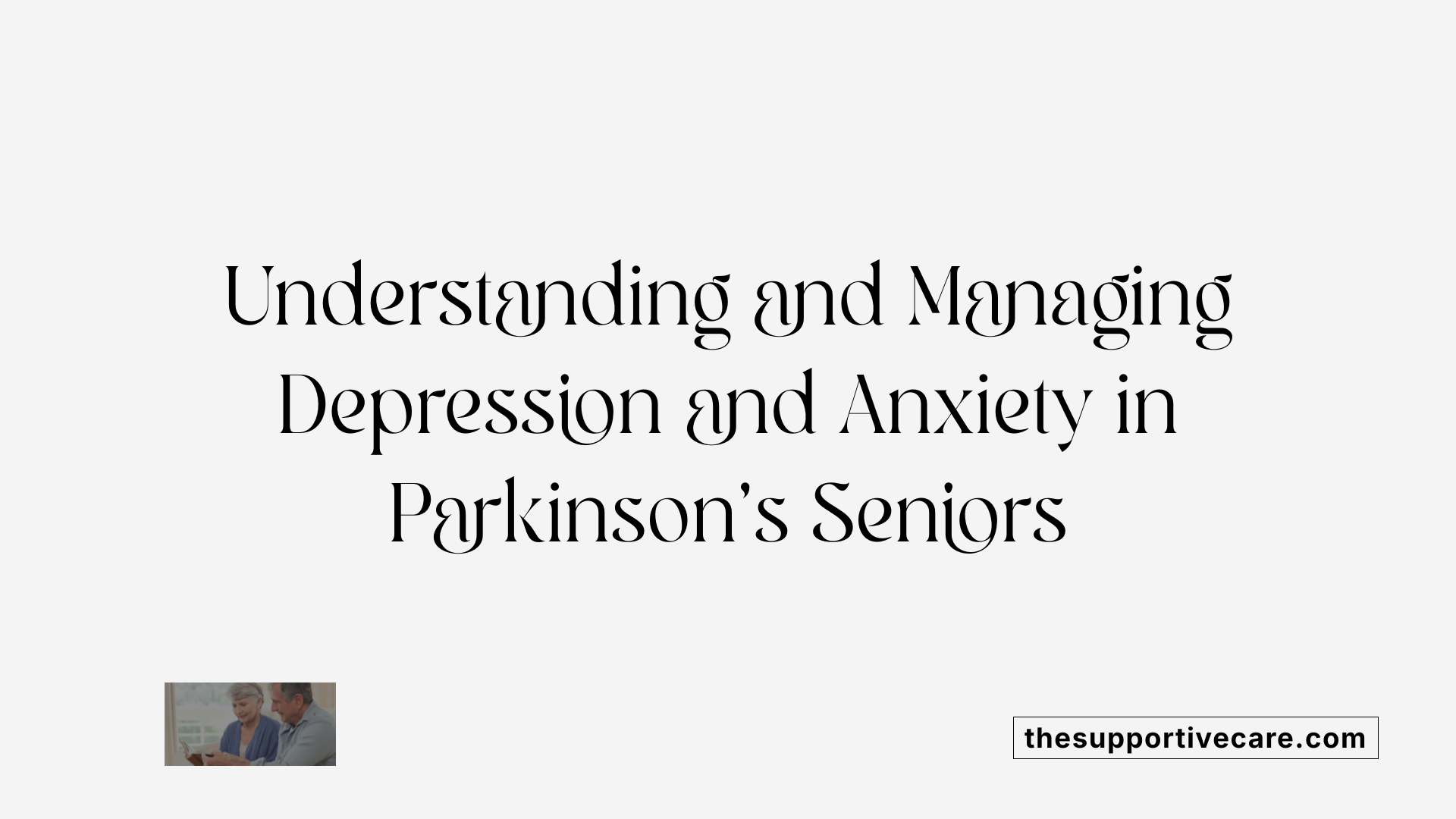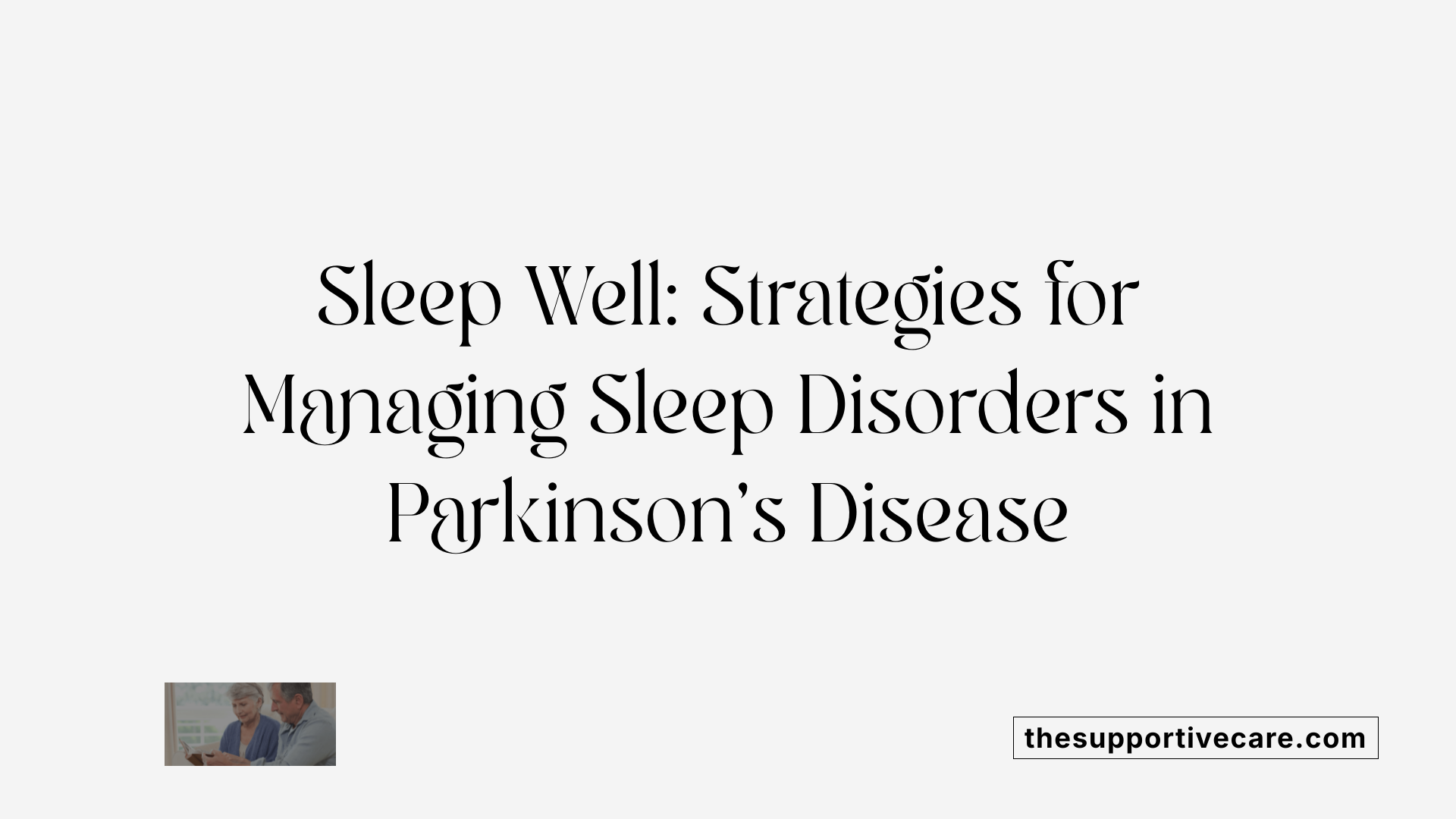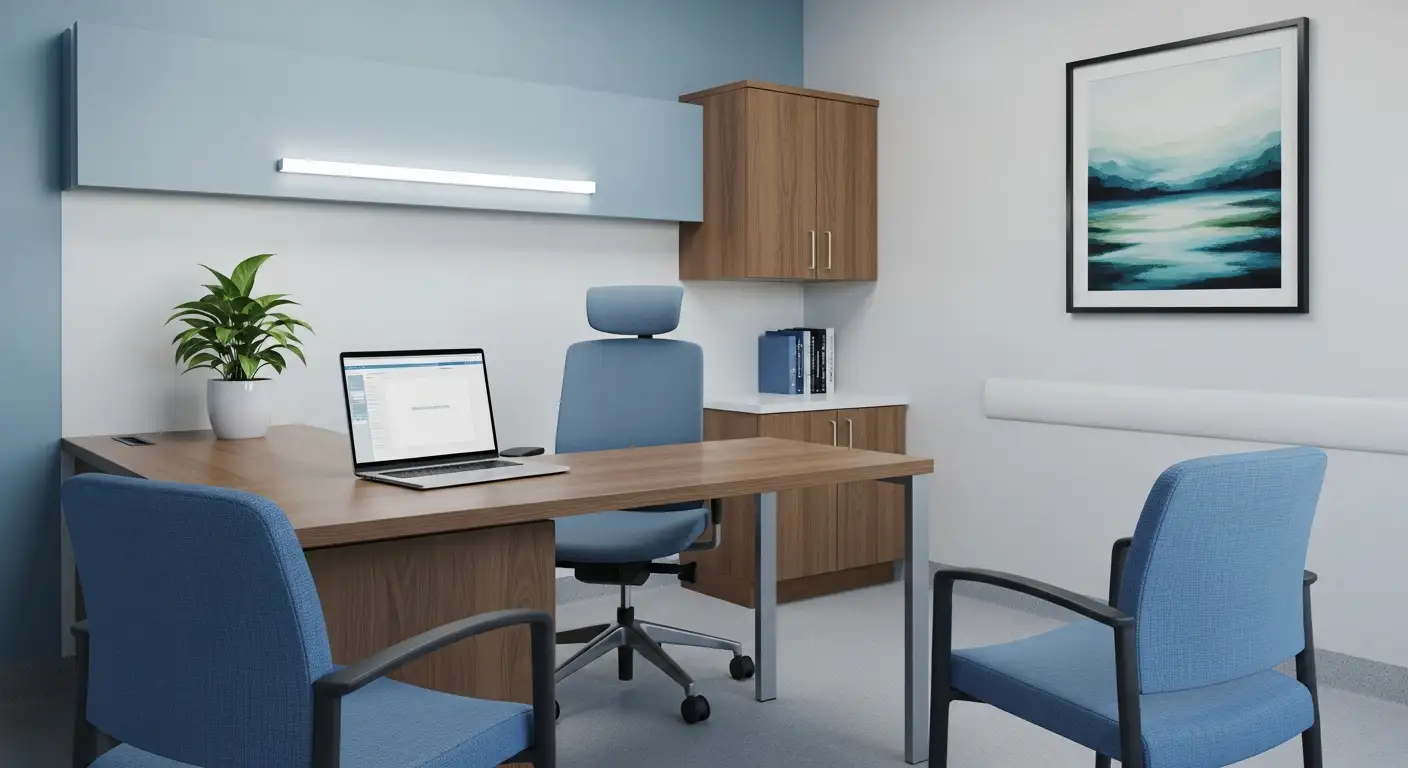Understanding Parkinson’s Disease Beyond Motor Symptoms
Parkinson's disease (PD) is widely recognized for its characteristic motor symptoms such as akinesia, bradykinesia, resting tremor, and rigidity. However, the non-motor and behavioral symptoms—including cognitive impairments, psychiatric disorders, and sleep disturbances—play a profound role in diminishing quality of life for seniors living with PD. Addressing these symptoms via targeted behavioral interventions is crucial for comprehensive care.
The Spectrum of Behavioral and Psychiatric Symptoms in Parkinson’s Disease

Common Behavioral Symptoms in PD
Parkinson’s disease (PD) is not only marked by motor symptoms such as bradykinesia and tremor, but also by a variety of behavioral symptoms. These include impulse control disorders, apathy, and psychosis, which are frequently observed in PD patients. Behavioral symptoms may arise partly due to manipulation of dopaminergic treatment, which can trigger or exacerbate hyperdopaminergic behaviors. Deep brain stimulation of the subthalamic nucleus (STN) and continuous dopaminergic infusions have been shown to help reduce such behaviors, offering a better symptom management strategy.
Psychiatric Comorbidities
Psychiatric disorders commonly coexist with PD, significantly complicating patient care. Depression is the most prevalent psychiatric condition, affecting between 2.7% and 55.6% of patients. Anxiety disorders, including generalized anxiety disorder, are also common and often relate to PD’s motor limitations or medication fluctuations. Psychosis, characterized by hallucinations and delusions, typically emerges as disease progresses or through medication side effects. Treatment for psychosis includes atypical antipsychotics like clozapine and pimavanserin.
Cognitive impairments span from mild cognitive dysfunction to dementia and may occur at any disease stage. Rivastigmine and other cholinesterase inhibitors positively affect cognition and behavior, improving daily activities in patients with Parkinson’s disease dementia. Apathy stands out as a distinct motivational disorder often linked with cortical atrophy and may improve with dopaminergic agents such as pramipexole.
Impact on Quality of Life
The behavioral and psychiatric symptoms of PD profoundly affect patients’ quality of life. These nonmotor complications exacerbate disability beyond physical symptoms, influencing social functioning, emotional well-being, and adherence to treatment. Impulse control disorders due to dopamine agonists can disrupt everyday activities, while psychosis and cognitive impairment increase caregiver burden. Effective management involving pharmacologic approaches alongside behavioral therapies, including cognitive-behavioral therapy (CBT), can greatly enhance patients' outlook and day-to-day functioning.
Multidisciplinary care teams are essential to address this spectrum of symptoms comprehensively, integrating neurologists, psychiatrists, therapists, and other specialists to optimize treatment outcomes and improve quality of life for people living with Parkinson’s disease.
Depression and Anxiety: Prevalence and Treatment Strategies in PD Seniors

How common are depression and anxiety in Parkinson's disease seniors?
Depression is the most widespread psychiatric disorder among Parkinson's disease (PD) patients, with prevalence rates ranging significantly from 2.7% to as high as 55.6%. Anxiety disorders also occur frequently in this population, with generalized anxiety disorder identified as the most common subtype. These symptoms can arise as direct consequences of the disease, secondary to physical limitations imposed by PD, or related to fluctuations in medications.
What pharmacologic treatments are available for depression and anxiety in PD?
Selective serotonin reuptake inhibitors (SSRIs) and serotonin-norepinephrine reuptake inhibitors (SNRIs) form the cornerstone of pharmacologic therapy for depression in PD seniors. Among SSRIs, sertraline is considered particularly safe and effective. These medications help to modulate mood by altering neurotransmitter balance but must be used carefully to avoid exacerbating motor symptoms or causing interactions with existing dopaminergic treatments.
Are there effective nonpharmacological approaches?
Cognitive-behavioral therapy (CBT) has shown promising results in alleviating depression in Parkinson's disease patients. In a randomized controlled trial involving 80 depressed PD patients, CBT led to significant reductions in depression scores (HAM-D dropped from 20.93 to 13.58 over 10 weeks), with over half the participants responding to treatment compared to only 8% in control groups. Additional improvements were seen in anxiety, social functioning, and coping strategies. Benefits of CBT endured for at least one month post-treatment, highlighting its potential as a feasible and sustainable therapy that can complement medication.
Integrating CBT alongside pharmacologic regimens offers a multimodal approach that addresses both biological and psychosocial factors contributing to depression and anxiety in PD. This approach supports personalized care and improves overall quality of life in senior patients managing Parkinson’s disease.
Cognitive Dysfunction and Dementia in Parkinson’s Disease: Assessment and Management
Stages and Types of Cognitive Impairments in Parkinson's Disease
Cognitive dysfunction can arise at any stage of Parkinson's disease (PD). Patients may experience mild cognitive impairment initially, which can progress to Parkinson's disease dementia (PDD) as the neurodegenerative process advances. These impairments often involve executive function, attention, memory, and visuospatial abilities, significantly affecting patients' independence and quality of life.
Pharmacologic Treatments: Cholinesterase Inhibitors
Cholinesterase inhibitors, particularly rivastigmine, are approved treatments for cognitive symptoms associated with Parkinson's disease dementia. Rivastigmine works by enhancing cholinergic neurotransmission, which can improve cognition, behavior, and activities of daily living in affected patients. Its use is supported by clinical evidence showing benefits in slowing cognitive decline in PDD.
Non-Pharmacologic Treatment Strategies
Complementing medication, non-pharmacologic interventions play an essential role in managing cognitive dysfunction in PD. Cognitive training exercises can help maintain cognitive function by targeting specific deficits. Physical exercise is also beneficial, improving not only motor symptoms but also cognitive performance. These strategies aim to support brain health and enhance everyday functioning.
Together, pharmacologic and non-pharmacologic approaches form a comprehensive management plan for cognitive impairments in Parkinson's disease, tailored to disease stage and individual patient needs.
Impulse Control Disorders and Behavioral Dysregulation in Parkinson’s
Connection with dopaminergic medications
Impulse control disorders (ICDs) in Parkinson’s disease (PD) are often linked to the use of dopaminergic medications, particularly dopamine agonists. These drugs, while essential for managing motor symptoms, may lead to hyperdopaminergic behaviors that manifest as impaired impulse control. This relationship highlights the delicate balance clinicians must maintain between controlling PD motor symptoms and mitigating psychiatric side effects.
Clinical features of impulse control disorders
ICDs in PD include behaviors such as compulsive gambling, hypersexuality, binge eating, and compulsive shopping. These behaviors significantly impact patients' quality of life and may be accompanied by other behavioral or cognitive symptoms like apathy or psychosis. ICDs result from overstimulation of dopamine receptors, which can alter decision-making and reward systems in the brain.
Management including medication adjustments and behavioral therapy
Management of ICDs involves a multifaceted approach. The primary step often includes dose reduction or discontinuation of dopamine agonists if possible. Behavioral interventions, such as psychoeducation and cognitive-behavioral therapy (CBT), are important components to address underlying psychological triggers and improve coping strategies. Additionally, selective serotonin reuptake inhibitors (SSRIs) may be used to help regulate impulsivity and related mood disturbances. In some cases, deep brain stimulation (DBS) of the subthalamic nucleus (STN) and continuous dopaminergic infusions have demonstrated potential in reducing hyperdopaminergic behaviors by stabilizing dopamine levels.
Overall, managing ICDs requires ongoing assessment to balance motor control and behavioral health, often necessitating a collaborative, multidisciplinary care team to optimize outcomes for patients with Parkinson's disease.
Psychosis and Hallucinations: Identifying and Managing Challenging Symptoms
What causes psychosis and hallucinations in Parkinson's disease?
Psychosis in Parkinson's disease (PD) arises primarily due to disease progression and the effects of dopaminergic medications used to manage motor symptoms. As PD advances, neurodegenerative changes increase the vulnerability of patients to psychiatric complications, including psychosis. Medications that adjust dopamine levels can sometimes lead to overstimulation in certain brain areas, triggering hallucinations and delusions.
What are the common symptoms of psychosis in PD?
Patients with Parkinson's disease psychosis often experience:
- Visual hallucinations, the most frequent type, where patients see objects or people that aren't present.
- Auditory hallucinations, involving hearing sounds or voices.
- Delusions, including paranoid beliefs or false interpretations of reality.
These symptoms considerably impact quality of life and create challenges for patients and caregivers alike.
How are psychosis and hallucinations treated in Parkinson's disease?
Managing psychosis in PD involves balancing symptom control without worsening motor dysfunction:
- Atypical antipsychotics: Clozapine is effective and has a relatively favorable motor side effect profile but requires regular blood monitoring due to the risk of agranulocytosis.
- Pimavanserin: Specifically approved for Parkinson's psychosis, pimavanserin is a selective serotonin 5-HT2A inverse agonist that treats psychosis without exacerbating motor symptoms.
- Medication review: Reducing or adjusting dopaminergic therapies can sometimes mitigate psychotic symptoms.
These treatment modalities require individualized tailoring by a multidisciplinary team to optimize therapeutic outcomes while minimizing adverse effects.
Addressing Apathy as a Distinct Motivational Disorder in PD
What differentiates apathy from depression in Parkinson's disease?
Apathy in Parkinson's disease (PD) is a motivational disorder characterized by diminished initiation and goal-directed behavior. Unlike depression, it is not primarily driven by mood disturbances but rather by a lack of motivation and emotional indifference. Recognizing this distinction is vital since apathy often requires different clinical approaches than those used for depression.
What pharmacologic options are available for treating apathy in PD?
Dopaminergic agents have shown promise in improving apathy symptoms. Notably, pramipexole, a dopamine agonist, has been observed to alleviate apathy in some patients. Additionally, stimulants may also provide benefit by enhancing motivation, though careful monitoring is essential due to potential side effects.
How is apathy associated with brain cortical changes in PD?
Neuroimaging studies have linked apathy in PD to cortical atrophy, particularly in regions involved in motivation and executive function. These brain changes underscore the biological basis of apathy and highlight why it often persists independently of mood disorders. Understanding this association reinforces the need for targeted treatments addressing the specific neural substrates of apathy.
| Aspect | Description | Clinical Implication |
|---|---|---|
| Differentiation | Apathy involves lack of motivation without depressed mood | Requires evaluation separate from depression |
| Pharmacologic Treatment | Pramipexole and stimulants show potential benefits | Tailored dopaminergic therapy might improve symptoms |
| Neural Basis | Linked to cortical atrophy in motivational brain areas | Indicates biological underpinning needing targeted strategies |
Sleep Disorders in Parkinson’s Disease: Prevalence and Behavioral Management
What Are Common Sleep Disturbances in Parkinson’s Disease?
Sleep disorders frequently complicate Parkinson’s disease (PD), significantly impacting quality of life. Among these, insomnia is prevalent, causing difficulties in falling or staying asleep.
REM sleep behavior disorder (RBD) is notably common in PD; characterized by vivid dreams and enactment of dreams during REM sleep, it can lead to injury. Restless legs syndrome (RLS) and obstructive sleep apnea (OSA) also occur often, further fragmenting sleep.
How Are Sleep Disorders Treated in Parkinson’s Disease?
Management strategies for sleep disturbances in PD include pharmacological and non-pharmacological approaches tailored to specific conditions:
RBD: Melatonin is typically the first-line treatment, valued for its safety profile. Clonazepam serves as an effective alternative, particularly when melatonin is insufficient.
OSA: Continuous positive airway pressure (CPAP) therapy is the cornerstone of treatment, effectively reducing apneas and improving sleep quality.
General Sleep Disturbances: Medication adjustments—especially of dopaminergic treatments—may alleviate symptoms. In some cases, adding or optimizing agents like gabapentin or duloxetine might assist.
Why Is Sleep Hygiene Important?
Beyond medications, practicing good sleep hygiene is essential to support restful sleep in PD patients. This includes:
- Maintaining a consistent sleep schedule
- Creating a comfortable, dark, and quiet sleep environment
- Limiting caffeine and stimulating activities before bedtime
- Engaging in regular daytime physical activity
Together with clinical treatments, these behavioral strategies help manage sleep problems effectively.
Table: Overview of Sleep Disorder Management in Parkinson’s Disease
| Sleep Disorder | Treatment Approach | Notes |
|---|---|---|
| REM Sleep Behavior Disorder (RBD) | Melatonin, Clonazepam | Melatonin preferred; clonazepam alternative if needed |
| Obstructive Sleep Apnea (OSA) | CPAP | Gold standard therapy to prevent airway collapse |
| Insomnia and Other Disturbances | Medication review, sleep hygiene | Adjust dopaminergic meds; emphasize behavioral changes |
Effective management of sleep problems requires individualized care, combining appropriate medications with lifestyle modifications to enhance overall well-being in people with Parkinson’s disease.
Role and Impact of Deep Brain Stimulation and Dopaminergic Infusions in Behavioral Symptoms

Use of STN Deep Brain Stimulation
Deep brain stimulation (DBS) targeting the subthalamic nucleus (STN) is a well-established therapeutic approach for managing motor symptoms in Parkinson's disease (PD). Beyond its motor benefits, STN DBS has gained recognition for its ability to influence behavioral symptoms. By modulating neural circuits, STN DBS can help alleviate hyperdopaminergic behaviors, which often complicate PD management.
Continuous Dopaminergic Infusions Benefits
Continuous dopaminergic infusions, such as levodopa-carbidopa intestinal gel or apomorphine infusions, provide a steady delivery of dopamine replacement therapy. This approach avoids the peaks and troughs of oral medications that can trigger behavioral complications. Maintaining more stable dopamine levels helps mitigate impulse control disorders and other hyperdopaminergic symptoms.
Effect on Hyperdopaminergic Behaviors
Hyperdopaminergic behaviors in PD, including impulse control disorders such as compulsive gambling, shopping, or eating, can primarily be induced or worsened by pulsatile dopaminergic treatment. Both STN DBS and continuous dopaminergic infusions have demonstrated efficacy in reducing these behaviors by providing more physiologic dopamine stimulation or enabling medication dose reductions. This reduction improves patients' quality of life by balancing motor control with behavioral stability.
Cognitive-Behavioral Therapy (CBT) for Depression in Parkinson’s Disease: Evidence and Outcomes
What does research say about CBT in depressed PD patients?
A randomized controlled trial involving 80 depressed Parkinson's disease patients has shown promising results for cognitive-behavioral therapy (CBT). About 90% of participants completed the study, providing robust data to evaluate CBT effects. The intervention was tailored specifically for PD patients, addressing their unique challenges.
How effectively does CBT reduce depression in PD?
CBT led to significant reductions in depression severity. Scores on the Hamilton Depression Rating Scale (HAM-D) dropped notably from a baseline average of 20.93 to 13.58 by week 10 of treatment. Effect sizes were large (Cohen's d=1.59 on HAM-D), indicating a strong therapeutic impact. Importantly, 56% of participants receiving CBT responded to treatment at week 10, vastly outperforming the 8% response in the control group. These improvements were sustained through a 1-month follow-up.
Beyond depression: Impact of CBT on anxiety, social functioning, and motor symptoms
In addition to alleviating depression, CBT participants exhibited meaningful improvements in anxiety levels, as measured by self-reported scales such as the Beck Depression Inventory. Social functioning also enhanced, with patients adopting more positive coping strategies like reframing stressful situations constructively. Remarkably, motor symptom ratings improved, suggesting that behavioral therapy can provide benefits beyond mood disorders, potentially through indirect facilitation of engagement in physical activity and better management of PD symptoms.
These findings underscore CBT as a feasible and effective treatment option for depression in Parkinson’s disease. It provides wide-ranging benefits that contribute to improving quality of life for this patient population.
Integrated Behavioral Health Care for Seniors with Parkinson’s Disease
What is Integrated Behavioral Health Care and Why Is It Important for Seniors with Parkinson’s Disease?
Integrated behavioral health care (BHI) is a collaborative, patient-centered approach that involves coordinated care among primary care providers and behavioral health clinicians. This model is especially vital for seniors with Parkinson’s disease (PD), who frequently experience complex neuropsychiatric symptoms such as depression, anxiety, cognitive impairment, psychosis, and impulse control disorders.
How Does Integrated Care Benefit Neuropsychiatric Comorbidities in Parkinson’s Disease?
Neuropsychiatric comorbidities significantly affect the quality of life in PD patients. Managing these conditions through integrated care enables timely identification and comprehensive treatment:
- Early Detection: Screening tools like the PHQ-9 for depression and GAD-7 for anxiety allow clinicians to recognize symptoms promptly.
- Comprehensive Management: Treatment plans incorporate pharmacologic therapies (e.g., SSRIs and cholinesterase inhibitors), psychotherapies such as cognitive-behavioral therapy (CBT), and lifestyle modifications.
- Continuity of Care: Ongoing collaboration among neurologists, psychiatrists, and primary care providers ensures symptom monitoring and adjustments.
How are Primary Care and Behavioral Health Clinicians Engaged?
Primary care clinicians play a crucial frontline role in identifying behavioral health concerns in seniors with PD. Through integrated behavioral health care:
- Providers work together within multidisciplinary teams, ensuring that psychiatric symptoms linked to PD motor and nonmotor complications are addressed.
- Behavioral health specialists deliver targeted interventions like CBT, which has demonstrated efficacy in reducing depression and anxiety in PD patients.
- Education and psychoeducation support patients and caregivers, enhancing adherence and coping strategies.
This collaborative approach improves patient outcomes by addressing the multifaceted challenges of aging with Parkinson’s disease, ultimately enhancing both mental health and overall function in this vulnerable population.
Screening and Early Assessment Tools for Behavioral Health in Seniors with PD
Usage of PHQ-9, GAD-7, MMSE, and MoCA
Screening for behavioral health issues in seniors with Parkinson's disease (PD) is vital for effective management and improved outcomes. Commonly used tools include the Patient Health Questionnaire-9 (PHQ-9) for depression, the Generalized Anxiety Disorder-7 (GAD-7) scale for anxiety, and cognitive assessments like the Mini-Mental State Examination (MMSE) and Montreal Cognitive Assessment (MoCA).
The PHQ-9 is a validated tool that helps detect depression severity, which is highly prevalent among older adults with PD. Similarly, GAD-7 screens for anxiety disorders that often co-occur in this population, helping to differentiate anxiety symptoms from PD-induced physiological issues or medication effects.
Cognitive screening through MMSE and MoCA is essential since PD patients may experience mild cognitive impairment or progress to Parkinson's disease dementia. These brief tools facilitate identification of cognitive deficits early in the disease course, allowing timely interventions.
Importance of Early Detection
Early identification of depression, anxiety, cognitive decline, and other psychiatric symptoms enables tailored treatment plans that can significantly enhance quality of life. Behavioral symptoms, if unmanaged, can worsen disability and complicate PD management. Recognizing neuropsychiatric symptoms early helps in differentiating PD-related changes from other causes and guides appropriate referrals to specialists.
Influence on Treatment Planning
Results from these screening tools inform both pharmacologic and nonpharmacologic strategies. For example, detecting depression with PHQ-9 supports initiating selective serotonin reuptake inhibitors or cognitive-behavioral therapy (CBT). Cognitive assessment outcomes guide the use of cholinesterase inhibitors like rivastigmine for dementia management or non-drug interventions such as cognitive training.
Screening also alerts clinicians to impulse control disorders or psychosis that may be medication-related, prompting dopaminergic therapy adjustments or behavioral interventions. This integrated assessment approach ensures comprehensive care tailored to individual neuropsychiatric profiles.
Incorporating these screening tools into routine clinical practice is a cornerstone of multidisciplinary behavioral health care for seniors with Parkinson's disease, helping to optimize clinical outcomes and patient well-being.
Addressing Substance Abuse and Co-occurring Mental Health Issues in Older Adults
Prevalence of substance misuse and SUD in seniors
Substance misuse and Substance Use Disorders (SUDs) affect about 20% of older adults, often involving prescription and over-the-counter medications. This older population is particularly vulnerable due to a growing number of seniors aged 65 and over, many of whom face concurrent behavioral health challenges such as depression and anxiety. The unique nature of substance abuse in seniors requires heightened attention, given that their symptoms often differ from younger populations and may be masked by medical comorbidities.
Risks related to polypharmacy and physiological changes
Older adults face increased risks from substance misuse due to polypharmacy — the use of multiple medications — which can lead to harmful drug interactions and increased side effects. Physiological changes with aging alter drug metabolism and sensitivity, further complicating treatment. These factors contribute to cognitive decline, fall risk, and worsening of chronic diseases. Therefore, careful medication management and monitoring are essential to reducing adverse outcomes.
Integration of treatment services
Comprehensive treatment for substance abuse and mental health issues in seniors involves a multidisciplinary, integrated approach. These services combine medical care, psychotherapy, behavioral interventions, and medication management tailored to individual needs. Support groups and peer counseling offer vital ongoing encouragement.
Detoxification programs can safely address withdrawal symptoms, followed by inpatient or outpatient rehabilitation. Crucially, treatment also addresses co-occurring psychiatric disorders such as depression, anxiety, and neuropsychiatric symptoms from conditions like dementia.
Collaborative care models — involving primary care providers, behavioral health specialists, pharmacists, and social workers — optimize outcomes by addressing both physical and mental health. Non-pharmacological therapies like cognitive-behavioral therapy (CBT), exercise, and lifestyle modification enrich the treatment landscape for older adults.
What comprehensive services are available for treating substance abuse and mental health issues?
Comprehensive services encompass a wide range of integrated approaches including medical oversight, psychotherapy, behavioral therapies, medication management, and crisis interventions. Individualized treatment plans target both addiction and underlying psychological conditions. Supplemental support such as peer counseling and group therapy fosters community connection and relapse prevention. Detoxification programs initiate recovery safely, progressing to rehabilitation settings that may be inpatient or outpatient depending on need. Ultimately, these services aim to promote mental wellness, prevent relapse, and improve quality of life for older adults struggling with substance use and mental health disorders.
Effective Strategies in Addiction Treatment for Older Adults with Parkinson's Disease
How do treatment programs address various forms of addiction effectively?
Treatment programs for addiction in older adults, including those with Parkinson's disease (PD), emphasize personalized care tailored to each individual's unique circumstances. This customization is especially important given the complex interplay between PD's neurodegenerative features, psychiatric symptoms, and potential substance misuse.
Programs often begin with medical detoxification to safely manage withdrawal symptoms. Following detox, counseling and behavioral therapies such as cognitive-behavioral therapy (CBT) are implemented to address harmful thought patterns and behaviors contributing to addiction. CBT is particularly effective, as evidenced in PD populations where it has also been shown to improve depression and anxiety alongside addiction recovery.
Relapse prevention forms a central pillar of these interventions, equipping patients with coping skills and strategies to maintain long-term sobriety despite challenges. Ongoing support via outpatient care, peer support groups, and follow-up counseling helps sustain recovery efforts.
How does integration of mental health and substance abuse treatments enhance outcomes?
Given that many seniors with PD face comorbid psychiatric conditions such as depression, anxiety, or impulse control disorders, integrated behavioral health care (BHI) models have become essential. BHI brings together primary care providers, mental health clinicians, and addiction specialists into collaborative, patient-centered teams.
These integrated approaches ensure that mental health disorders and substance misuse are treated simultaneously rather than in isolation, reducing gaps in care and improving overall quality of life. For example, treatment plans may combine pharmacologic therapies like selective serotonin reuptake inhibitors (SSRIs) for depression with behavioral interventions targeting addiction. This comprehensive care addresses the complex needs of older adults with PD more effectively.
What role do relapse prevention and ongoing support play in sustaining recovery?
Relapse prevention is critical in addressing addiction among older adults with PD. Strategies include psychoeducation, behavioral therapy, and medication adjustments to manage simultaneously occurring PD symptoms and neuropsychiatric complications.
Continued support services such as access to support groups, tailored psychotherapy, and coordinated follow-up care help maintain sobriety and psychological well-being. Furthermore, considering social determinants and caregiver involvement enhances engagement and adherence to recovery plans.
Such ongoing support not only mitigates relapse risk but also contributes to managing PD-related psychiatric challenges like depression, anxiety, and impulse control disorders, which can otherwise complicate addiction treatment.
| Strategy | Description | Specific Considerations in PD |
|---|---|---|
| Personalized Interventions | Tailored therapies based on patient's addiction type and PD specifics | Adjusting for dopaminergic medication effects and nonmotor symptoms |
| Integrated Care Models | Collaborative mental health and addiction treatment teams | Coordinated management of depression, anxiety, and impulse control disorders |
| Relapse Prevention | Therapies and education to avoid return to substance use | Addressing PD neuropsychiatric symptoms and medication-related side effects |
| Ongoing Support | Continuous outpatient care, support groups, caregiver involvement | Enhances long-term sobriety and manages fluctuating PD symptoms |
Non-Pharmacologic Interventions: The Role of Exercise and Cognitive Training

Benefits of physical activity on cognition and mood
Physical activity is an essential component of managing Parkinson's disease, not only improving motor symptoms but also enhancing cognitive function and mood. Exercise promotes neuroplasticity and supports brain health, which can help mitigate cognitive decline and depressive symptoms common in PD patients. Regular physical activity has been shown to improve overall quality of life by reducing apathy and anxiety while boosting social functioning and coping strategies.
Cognitive training techniques for PD dementia
Cognitive training for patients with Parkinson's disease dementia involves structured activities designed to enhance memory, attention, problem-solving, and executive functioning. Techniques include computerized brain exercises, memory drills, and strategy-based therapies that aim to slow cognitive deterioration. These non-pharmacologic interventions complement cholinesterase inhibitors, like rivastigmine, which are used to treat cognitive symptoms in PD dementia.
Synergistic effects with pharmacologic treatments
Combining exercise and cognitive training with pharmacologic therapies provides a holistic approach to managing Parkinson's disease. Physical activity may enhance the effectiveness of dopaminergic medications by improving motor control and mood, while cognitive training supports medication effects on mental function. Together, these interventions contribute to better daily functioning and reduced behavioral symptoms. Moreover, therapies such as cognitive-behavioral therapy (CBT) can further amplify benefits by addressing depression and anxiety, resulting in a more comprehensive care strategy for PD patients.
Multidisciplinary Care Teams: Coordinating Motor and Behavioral Health Management
Roles of therapists, psychiatrists, neurosurgeons, and other specialists
Managing Parkinson's disease (PD) requires a team-based approach involving various specialists who address the broad spectrum of motor and nonmotor symptoms. Physical therapists work to maintain mobility and manage tremors and rigidity through tailored exercise programs. Occupational therapists focus on enhancing daily living activities, helping patients to maintain independence despite motor challenges. Speech-language pathologists assist with speech and swallowing difficulties common in PD.
Psychiatrists play a crucial role in managing psychiatric symptoms such as depression, anxiety, psychosis, and impulse control disorders. They tailor pharmacotherapy, including use of SSRIs, SNRIs, antipsychotics like pimavanserin and clozapine, and coordinate behavioral therapies like cognitive-behavioral therapy (CBT). Neurosurgeons are involved in interventions such as deep brain stimulation (DBS), particularly targeting the subthalamic nucleus, which can alleviate motor symptoms and reduce hyperdopaminergic behaviors.
Additional specialists include nutritionists who guide dietary management to counteract weight loss and gastrointestinal symptoms; urologists handling urinary dysfunction; gastroenterologists addressing constipation; and others who help manage autonomic and systemic manifestations.
Comprehensive Symptom Management
The multidisciplinary team collaboratively addresses the multifaceted nature of PD. Motor symptoms such as akinesia, rigidity, and tremor are managed alongside nonmotor complications including cognitive impairment, sleep disorders, apathy, and psychosis. Medication regimens are carefully adjusted to balance symptom control and side effects, often requiring integrated input from neurologists, psychiatrists, and therapists.
Nonpharmacological interventions, such as physical therapy and cognitive training, complement pharmacologic treatments. For example, cholinesterase inhibitors improve cognition and behavior in Parkinson's dementia, while CBT has shown efficacy in reducing depression and anxiety.
Sleep disturbances, pain, and autonomic dysfunction are similarly addressed with a combination of medications (e.g., melatonin for REM sleep behavior disorder), lifestyle modifications, and specialist input. Osteoporosis risk necessitates monitoring and preventive care coordinated by the team.
Importance of Coordination in Treatment Plans
Effective PD management hinges on seamless communication and coordination among team members. Integration of behavioral health care into primary and specialty care ensures timely identification and treatment of psychiatric and cognitive symptoms, improving patients’ quality of life.
Multidisciplinary collaboration fosters personalized treatment plans that account for the complex interplay between dopaminergic therapies, psychiatric symptoms, and motor function. This approach reduces risks such as impulse control disorders and psychosis induced by medication while enhancing overall functional status.
By uniting expertise across disciplines, multidisciplinary care teams deliver comprehensive, patient-centered management that addresses the full spectrum of PD manifestations.
Sleep Hygiene and Behavioral Interventions for Parkinson’s-Related Sleep Disorders

Education on Sleep Hygiene Practices
Sleep hygiene education plays a crucial role in managing common Parkinson’s disease (PD) sleep disturbances such as insomnia and REM sleep behavior disorder (RBD). Patients are instructed to maintain consistent sleep and wake times, create a calm sleep environment, and avoid stimulants like caffeine and excessive screen time before bedtime. These practices help regulate the sleep-wake cycle and reduce nighttime awakenings.
Adjunct Behavioral Strategies
In addition to basic sleep hygiene, several behavioral strategies support better sleep quality in PD. Relaxation techniques such as progressive muscle relaxation, mindfulness meditation, and controlled breathing exercises can ease anxiety and facilitate sleep onset. Cognitive-behavioral therapy (CBT), tailored for PD patients, further reduces insomnia symptoms and addresses related anxiety or depression that interfere with sleep. Treatment for RBD often includes melatonin and sometimes clonazepam, complemented by safety measures to prevent injury during vivid dreaming episodes.
Relation to Improved Motor and Cognitive Function
Improving sleep quality has broad benefits beyond restfulness for individuals with Parkinson’s disease. Restorative sleep enhances motor function by potentially reducing daytime fatigue and improving mobility and coordination. Additionally, better sleep can mitigate cognitive decline by supporting memory consolidation and executive functioning, which are often impaired in PD. Thus, behavioral sleep interventions contribute to the overall management of PD symptoms, improving both quality of life and functional outcomes.
Managing Autonomic Dysfunction Through Behavioral and Pharmacological Means
What Symptoms Are Associated with Autonomic Dysfunction in Parkinson's Disease?
Autonomic dysfunction in Parkinson's disease commonly includes symptoms such as orthostatic hypotension (a drop in blood pressure upon standing), urinary symptoms like urgency or incontinence, constipation, and erectile dysfunction. These nonmotor symptoms can significantly affect quality of life and require targeted management.
How Can Dietary and Lifestyle Modifications Help Manage Autonomic Symptoms?
Several lifestyle and dietary changes are beneficial in managing autonomic dysfunction. Increasing salt and fluid intake helps counteract low blood pressure and maintain hydration, which can reduce episodes of orthostatic hypotension. Patients are advised to avoid sudden position changes and to rise slowly from sitting or lying to standing to minimize dizziness. Maintaining regular bowel habits through diet high in fiber and hydration assists with constipation. Additionally, pelvic floor exercises and bladder training may improve urinary symptoms.
What Medication Strategies Assist in Controlling Autonomic Symptoms?
Pharmacological management is often necessary alongside lifestyle modifications. Medications such as midodrine and droxidopa are commonly prescribed to elevate blood pressure and help control orthostatic hypotension effectively. For urinary symptoms, drugs targeting bladder overactivity may be used but require careful consideration due to side effects. Constipation may be managed with stool softeners and laxatives when dietary measures are insufficient. Since autonomic symptoms can fluctuate, ongoing monitoring and individualized dose adjustments are recommended for optimal symptom control.
Together, behavioral modifications and careful medication management play a crucial role in improving autonomic dysfunction in Parkinson's disease, supporting patients' autonomy and enhancing their daily functioning.
Addressing Pain and Osteoporosis in Seniors with Parkinson’s Disease
What Are Effective Pain Management Options for Parkinson’s Disease?
Pain is a common nonmotor symptom in Parkinson's disease and can significantly impair quality of life for seniors. Management strategies often begin with nonpharmacologic approaches such as physical therapy, which helps improve mobility and alleviate musculoskeletal discomfort. When medication is needed, analgesics like acetaminophen or NSAIDs may be used cautiously. Neuropathic pain can be treated with drugs such as gabapentin or duloxetine.
In cases where pain is refractory to other treatments, deep brain stimulation—a surgical intervention targeting motor pathways—can also provide symptom relief by modifying neural circuits associated with pain perception.
How Is Bone Health Monitored and Protected in Parkinson’s Patients?
Seniors with Parkinson's disease face an increased risk of osteoporosis and related fractures. Routine screening of bone mineral density is recommended to detect bone loss early. Preventive measures include ensuring adequate calcium and vitamin D intake, engaging in weight-bearing exercises to maintain bone strength, and minimizing fall risks through environmental modifications.
Medications or supplements may be prescribed based on individual risk assessments to strengthen bone density and reduce fracture risk.
What Role Does Interdisciplinary Care Play in Managing Pain and Bone Health?
Comprehensive care for pain and osteoporosis in Parkinson’s disease requires a multidisciplinary approach. Physical therapists design tailored exercise programs addressing both mobility and bone health. Occupational therapists assist in modifying tasks to reduce strain and injury risk.
Neurologists oversee Parkinson's specific treatments while coordinating with psychiatrists and pain specialists to address overlapping symptoms such as depression and chronic pain. Nutritionists support dietary plans that promote overall health and bone integrity.
Urologists and gastroenterologists manage autonomic complications that could indirectly exacerbate fall risk. Neurosurgeons may be involved in advanced interventions like deep brain stimulation when appropriate.
Coordination among these professionals ensures personalized, holistic care that addresses the complex needs of seniors living with Parkinson’s disease.
The Importance of Monitoring Nonmotor Symptoms for Holistic Parkinson’s Care
What Nonmotor Symptoms Are Common in Parkinson's Disease?
Parkinson's disease (PD) is widely recognized for its motor symptoms like tremor and rigidity, but nonmotor symptoms also profoundly impact patients' quality of life. These include cognitive decline, mood disturbances such as depression and anxiety, psychosis (including hallucinations and delusions), and various sleep disorders like REM sleep behavior disorder and insomnia.
Why Is Regular Assessment of These Symptoms Crucial?
Nonmotor symptoms often emerge at any stage of PD and can worsen as the disease progresses. Monitoring these symptoms regularly allows clinicians to:
- Detect cognitive impairment early, facilitating timely interventions such as cholinesterase inhibitors like rivastigmine.
- Recognize mood disorders early to initiate safe pharmacological treatments (e.g., SSRIs, SNRIs) and non-pharmacological therapies such as cognitive-behavioral therapy (CBT).
- Identify psychotic symptoms associated with medications or disease severity, enabling management with agents like pimavanserin or clozapine.
- Address sleep disturbances promptly with appropriate treatments, including melatonin or clonazepam.
Assessment tools such as the Montreal Cognitive Assessment (MoCA), PHQ-9 for depression, and clinical evaluations for psychosis are essential components of routine follow-up.
How Should Therapeutic Strategies Be Adjusted?
Ongoing evaluation helps tailor individual treatment plans. For example:
- Dopaminergic therapy adjustments or deep brain stimulation may reduce hyperdopaminergic behavioral issues and impulse control disorders.
- Initiation or modification of cholinesterase inhibitors can help mitigate cognitive decline.
- Psychotropic medications require careful balancing to minimize motor side effects.
- Integrating multidisciplinary care—including psychiatrists, neurologists, occupational therapists, and behavioral health specialists—supports comprehensive symptom management.
Combining medication optimization with behavioral interventions and lifestyle strategies improves overall well-being and functional abilities for people living with PD.
| Symptom Type | Assessment Tools | Treatment Approach |
|---|---|---|
| Cognitive Decline | MoCA, MMSE | Rivastigmine, cognitive training |
| Mood Disorders | PHQ-9, HAM-D, Beck Inventory | SSRIs, SNRIs, CBT |
| Psychosis | Clinical evaluation | Pimavanserin, clozapine |
| Sleep Disorders | Sleep studies, patient diary | Melatonin, clonazepam, sleep hygiene |
Regular monitoring and individualized treatment are indispensable for addressing the complex nonmotor symptoms in PD, ultimately contributing to holistic patient care.
The Role of Caregivers and Social Support in Behavioral Interventions
Engagement of caregivers in treatment plans
Caregivers play a crucial role in the management of behavioral symptoms in Parkinson's disease (PD). Their involvement in treatment planning helps ensure that interventions are tailored to the patient’s daily routines and specific challenges. Caregivers often assist with medication management, monitor behavioral changes, and provide emotional support, which are essential for optimizing treatment outcomes. Collaborative communication between healthcare providers and caregivers supports adherence and timely adjustment of therapies such as dopaminergic treatments or cognitive-behavioral therapy (CBT).
Addressing social determinants of health
Behavioral health in older adults with PD is influenced by numerous social determinants including socioeconomic status, access to healthcare, social isolation, and cultural factors. Effective behavioral interventions incorporate strategies that consider these determinants to improve engagement and reduce barriers to care. For example, providing caregiver support resources and culturally competent education can enhance understanding and management of complex neuropsychiatric symptoms, including depression, anxiety, and impulse control disorders.
Enhancing patient adherence and wellbeing
Caregiver involvement strengthens patient adherence to medication regimens and nonpharmacological therapies like CBT and physical exercise, which are critical for improving mental health and motor symptoms. By fostering supportive environments, caregivers help mitigate the impact of symptoms such as apathy and psychosis, promoting better social functioning and quality of life. Social support also contributes to sustained benefits of behavioral treatments, as seen in studies where CBT participants experienced lasting improvements in depression and anxiety.
In summary, caregiver engagement and structured social support are indispensable components of behavioral intervention strategies in Parkinson's disease. They enhance individualized care delivery, address important psychosocial factors, and ultimately contribute to improved patient outcomes and wellbeing.
Policy, Billing, and Sustainable Models for Behavioral Health Integration in Senior Care
Healthcare Policy Support for Integrated Care
Integrated behavioral health care (BHI) emphasizes collaborative, patient-centered care between primary care and behavioral health clinicians. This approach is particularly beneficial for seniors with neuropsychiatric conditions such as Parkinson's disease, where complex behavioral health needs coexist with motor and nonmotor symptoms. Federal agencies like SAMHSA provide authoritative guidelines and resources that promote evidence-based interventions, supporting the integration of mental health and substance abuse treatment within primary care settings.
Billing and Coding Considerations
To ensure the sustainability of behavioral health integration, practices must navigate billing and coding frameworks effectively. Understanding reimbursement policies for mental health services, including psychotherapy and medication management, is critical. Accurate use of diagnostic codes (e.g., for depression, anxiety, or Parkinson’s disease dementia) and procedural codes for interventions such as cognitive-behavioral therapy (CBT) facilitates appropriate compensation. Policy documents provide guidance on coding that supports multidisciplinary care, helping reduce administrative barriers and optimize practice revenue.
Implementing Sustainable Multidisciplinary Services
Sustainable models rely on a multidisciplinary team including neurologists, psychiatrists, physical and occupational therapists, speech-language pathologists, and other specialists. Coordinated care plans address both motor and nonmotor Parkinson’s symptoms, such as psychiatric disorders, cognitive impairment, and sleep disturbances. Incorporating nonpharmacologic approaches, patient and caregiver engagement, and attention to social determinants of health strengthens long-term outcomes. Integrating lifestyle interventions and community resources contributes to holistic management while supporting cost-effective care delivery.
Together, policy support, mindful billing practices, and collaborative multidisciplinary frameworks form the backbone of effective behavioral health services in senior Parkinson’s care, ultimately enhancing quality of life and reducing disability.
Toward Improved Outcomes: The Future of Behavioral Interventions in Parkinson’s Disease
Behavioral symptoms in seniors with Parkinson’s disease profoundly impact their health and quality of life, demanding comprehensive, multidisciplinary approaches that incorporate pharmacological and non-pharmacological treatments. Early identification coupled with integrated behavioral health services, including cognitive-behavioral therapy and tailored addiction management, supports improved functional outcomes. As research advances and collaborative care models evolve, sustained attention to screening, symptom monitoring, and caregiver involvement will remain essential. With coordinated efforts bridging medical, psychiatric, and social dimensions of care, behavioral interventions can significantly enhance the lives of seniors navigating Parkinson’s disease, fostering dignity, independence, and wellbeing.
References
- Current treatment of behavioral and cognitive symptoms ...
- Management of Psychiatric Disorders in Patients with ...
- Cognitive-Behavioral Therapy for Depression in ...
- Integrated Behavioral Health Care for Older Adults
- TIP 26 Treating Substance Use Disorder in Older Adults ...
- Parkinson Disease Treatment & Management



































































































